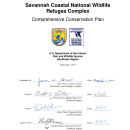What We Do
Wildlife conservation is at the heart of the National Wildlife Refuge System. It drives everything on U.S. Fish and Wildlife Service lands and waters managed within the Refuge System, from the purposes for which a national wildlife refuge national wildlife refuge
A national wildlife refuge is typically a contiguous area of land and water managed by the U.S. Fish and Wildlife Service for the conservation and, where appropriate, restoration of fish, wildlife and plant resources and their habitats for the benefit of present and future generations of Americans.
Learn more about national wildlife refuge is established to the recreational activities offered to the resource management tools used. Using conservation best practices, the Refuge System manages Service lands and waters to help ensure the survival of native wildlife species.
Threatened and Endangered Species
The seven miles of undeveloped beach at Wassaw NWR provide important nesting habitat for Atlantic loggerhead sea turtles. Due to its extensive long-term data set, collected by the non-profit Caretta Research Project, Wassaw NWR is considered one of the most important index beaches for the subpopulation of turtles that nest there. Wassaw's beach also contributes to the recovery of piping plovers by providing critical winter habitat for the shorebirds.
Invasive Species Control
In recent years, invasive, exotic plants and animals have become a serious threat to national wildlife refuges throughout the United States. Each year, three million acres of land are lost to exotic, invasive species invasive species
An invasive species is any plant or animal that has spread or been introduced into a new area where they are, or could, cause harm to the environment, economy, or human, animal, or plant health. Their unwelcome presence can destroy ecosystems and cost millions of dollars.
Learn more about invasive species , and billions of dollars are spent battling their infestation. Chinese tallow tree, ambrosia beetle, and feral hog are species from another area – often from another continent – that have been introduced here, locally. They reproduce rapidly, have few predators, and have low food value for wildlife. These species are a constant problem for refuge managers. Click here to learn more about invasive species.
Prescribed Fire
Fire has shaped the local landscape for eons. Because of the Georgia Coast's long history of lightning and man-made fires, natural systems are adapted to fire and depend on frequent fire to remain healthy. Prescribed burning plays a natural role in local ecosystems and is a vital tool for managing public lands. The extraordinarily high plant species diversity of the coastal ecosystems is maintained by fire, which reduces competition from woody plants and recycles nutrients. One of the greatest benefits of prescribed fire is that it reduces “fuels” – the underbrush, branches, pine needles, leaves, and dead plant debris that have built up on the forest floor over time. If fuels are not reduced every few years, wildfires can become intense, hot, and destructive.
Managed Hunts
Hunting is an important wildlife management tool that we recognize as a healthy, traditional outdoor pastime, deeply rooted in America’s heritage. Hunting can instill a unique understanding and appreciate of wildlife, their behavior, and their habitat needs. As practiced on refuges, hunting does not pose a threat to wildlife populations, and in some instances are necessary for sound wildlife management. For example, because their natural predators are gone, deer populations will often grow too large for the refuge habitat to support. Hunting programs can promote understanding and appreciation of natural resources and their management on lands and waters in the Refuge System.
Wassaw NWR offers two, three-day deer hunts annually. These hunts are open to all properly licensed hunters (no drawing); however, a $25 refuge hunt permit must be purchased in order to participate. For current hunting regulations and dates, and to purchase a hunting permit, please see the refuge's hunting activity page.
Management and Conservation
Refuges deploy a host of scientifically sound management tools to address biological challenges. These tools span active water management to wilderness character monitoring, all aimed at ensuring a balanced conservation approach to benefit both wildlife and people. At this field station our conservation tool box includes:
Planning – Comprehensive Conservation Plan
Climate Resilience
Compatibility Determinations
Cultural Resources
Education & Outreach
Fire Management
Invasive Species
Inventory and Monitoring
Law Enforcement
Recreation Management
Species Research
